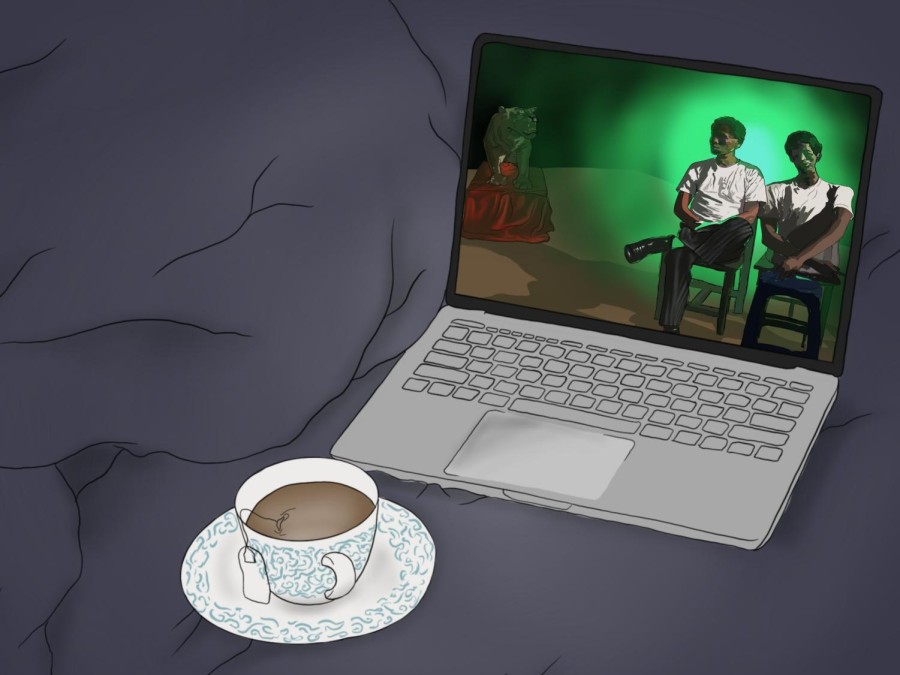Off the Radar: Lessons on how to film ‘The Act of Killing’
Off the Radar is a weekly column surveying overlooked films available to students for free via NYU’s streaming partnerships. “The Act of Killing” is available to stream on Kanopy and NYU Stream.
Joshua Oppenheimer’s “The Act of Killing” is available on Kanopy and NYU Stream. (Illustration by Aaliya Luthra)
March 10, 2023
The documentary film genre is often treated as the simple presentation of facts — a journalistic investigation that reveals answers to real-world phenomena. A passive camera appears to expose objective truths which would otherwise be hidden to the rest of the world. Yet, films like Joshua Oppenheimer’s “The Act of Killing” (2012) navigate the blurry lines that separate documentary from fiction.
The film focuses on individuals who participated in Indonesia’s vicious campaign of anti-communist killings under the Suharto military government. Following figures like Anwar Congo, a gangster turned paramilitary icon, the documentary has mass murderers reenact their crimes as stylized movie scenes. This unconventional approach forces both the subjects and viewers to confront traumatic memories, crafting one of the most viscerally unsettling cinematic experiences in recent decades.
Like Oppenheimer, many documentarians have covered topics of genocide, and they often do so with the aims of education and seeking closure. Perpetrators of unspeakable horrors are vilified in the eyes of the public.
What makes Oppenheimer’s film so distinct is his complex relationship with the on-screen characters. There is no question that Congo and his compatriots are reprehensible murderers. They openly accept their roles in the brutal torture and murder of thousands, showing no remorse for their actions. However, despite being aware of their bloody pasts, the audience may find themselves drawn to their infectious charisma. Congo addresses the camera with a familiar warmth, welcoming all of Oppenheimer’s questions and bringing a jovial energy to the screen. Here, the boogeyman of a national tragedy is more than a one-dimensional villain: He is an affable sadist.
Oppenheimer doesn’t seek to absolve Congo of his heinous crimes. In fact, filming his accounts of the massacres only serve to further incriminate the gangster. By spending time with Congo and having him take part in fictional recreations of his past, Oppenheimer makes him reflect on the implications of his actions. For decades, men like Congo have been celebrated in their role as violent extralegal enforcers for a military regime. Anyone who dared speak out against them would be marginalized and punished.
When savage killers are championed by society, welcomed into the arms of a community, they are often not able to perceive guilt. While most of the people involved in the massacres never show any signs of remorse, Congo is different. Toward the end of the film, after stepping into the shoes of one of the massacred, Congo begins to realize the gravity of his actions. For the first time, he considers the fear his victims felt.
“The Act of Killing” forces deep reflection, not just on a widely ignored historical atrocity, but also on the audience’s relationship to the film itself. Viewers grapple with burning questions. How does one interpret the truth when performance and reality are meshed seamlessly together? How does a filmmaker like Oppenheimer reconcile his close relationship with inhumane subjects? What is the viewer’s role in the legacy of violence and traumatic memories?
Unlike other documentaries which have a clear thesis, Oppenheimer’s film leaves the audience with more questions. “The Act of Killing” deeply and uncomfortably interrogates a collective memory of the past, while also desperately searching for humanity in the moral abyss.
Contact Mick Gaw at [email protected].

























































































































































